

New Harvard Study Measures Pesticide Accumulation In Bee Hive Honey: Alarming Results. Pesticides, which are sprayed in the amounts of billions of pounds per year, have been making a lot of noise lately.

This is because multiple published studies, and hundreds of scientists all over the world have identified (without a doubt) them as a catalyst for multiple major human health ailments, including cancer, Parkinson’s & Alzheimer’s disease, just to name a few. They’ve also been reported to have disastrous environmental consequences, but it doesn’t stop there. Another major concern regarding pesticides is the sudden loss of bees that the planet has been experiencing for the based few years. It’s quite concerning, which has scientists scrambling to figure out what’s going on, and it seems they’ve found it. Are Mushrooms the Solution to the Worldwide Bee Colony Collapse? Jefferey Jaxen | Wakingtimes As humanity becomes more conscious to the language of nature, it is clear that mushrooms in their many forms come in peace and are here to help.
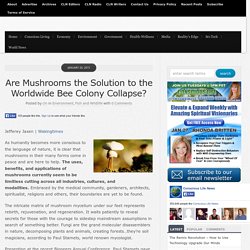
The uses, benefits, and applications of mushrooms currently seem to be limitless cutting across all industries, cultures, and modalities. Embraced by the medical community, gardeners, architects, spiritualist, religions and others, their boundaries are yet to be found. The intricate matrix of mushroom mycelium under our feet represents rebirth, rejuvenation, and regeneration.
It waits patiently to reveal secrets for those with the courage to sidestep mainstream assumptions in search of something better. Presenting at the recent Bioneers Annual Conference, Paul Stamets gave bombshell evidence that there is hope for bees, colony collapse, and our entire ecosystem. It has also been confirmed in previous tests that fungicidal contamination reduces beneficial fungi in honey bee colonies. Additional Sources: Link.Springer. Www.bulletinofinsectology.org/pdfarticles/vol67-2014-125-130lu.pdf. PLOS ONE: Crop Pollination Exposes Honey Bees to Pesticides Which Alters Their Susceptibility to the Gut Pathogen Nosema ceranae. Abstract Recent declines in honey bee populations and increasing demand for insect-pollinated crops raise concerns about pollinator shortages.
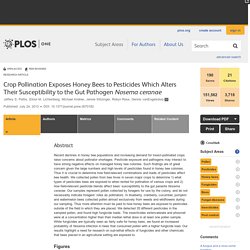
Pesticide exposure and pathogens may interact to have strong negative effects on managed honey bee colonies. Such findings are of great concern given the large numbers and high levels of pesticides found in honey bee colonies. Thus it is crucial to determine how field-relevant combinations and loads of pesticides affect bee health. We collected pollen from bee hives in seven major crops to determine 1) what types of pesticides bees are exposed to when rented for pollination of various crops and 2) how field-relevant pesticide blends affect bees’ susceptibility to the gut parasite Nosema ceranae.
Citation:Pettis JS, Lichtenberg EM, Andree M, Stitzinger J, Rose R, et al. (2013) Crop Pollination Exposes Honey Bees to Pesticides Which Alters Their Susceptibility to the Gut Pathogen Nosema ceranae. Editor: Fabio S. Introduction Methods Ethics Statement. The Link Between Mushrooms, Bees, and Mass Extinction. Alex Pietrowski, Staff WriterWaking Times From the perspective of the world’s most notable mycologist, there is nothing more dangerous to life on earth than deforestation because it is within the old growth forests of the world that ancient mycelial fungal networks live, providing crucial connections amongst nature that human beings still know very little about.
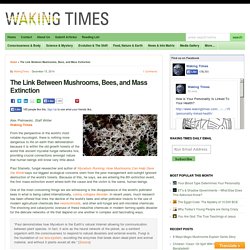
Paul Stamets, fungal researcher and author of Mycelium Running: How Mushrooms Can Help Save the World says our biggest ecological concerns stem from the poor management and outright ignorant destruction of the world’s forests. How plants may be evolving to the lack of bees. Plants which used to have two types of male reproductive organs – to increase their chances for fertilisation – are reverting back to one type.
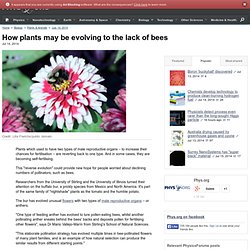
And in some cases, they are becoming self-fertilising. This "reverse evolution" could provide new hope for people worried about declining numbers of pollinators, such as bees. Researchers from the University of Stirling and the University of Illinois turned their attention on the buffalo bur, a prickly species from Mexico and North America. It's part of the same family of "nightshade" plants as the tomato and the humble potato. Are Your Delicious, Healthy Almonds Killing Bees?
Honeybees and almond blooms: mutual dependence Protasov AN/Shutterstock California dominates almond production like Saudi Arabia wishes it dominated oil.
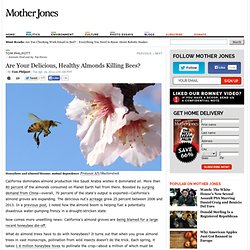
More than 80 percent of the almonds consumed on Planet Earth hail from there. Boosted by surging demand from China—overall, 70 percent of the state's output is exported—California's almond groves are expanding. The delicious nut's acreage grew 25 percent between 2006 and 2013. In a previous post, I noted how the almond boom is helping fuel a potentially disastrous water-pumping frenzy in a drought-stricken state. 7 Ideas for Helping to Protect the Honeybee. Alex Pietrowski, Staff WriterWaking Times With all of the immediate problems facing people these days, it is difficult to be concerned and proactive about the looming environmental crises that will affect us in big ways in the not-too-distant future.
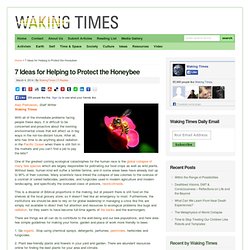
After all, who has time to do anything about radiation in the Pacific Ocean when there is still fish in the markets and you can’t find a job to pay the bills? One of the greatest coming ecological catastrophes for the human race is the global collapse of many bee species which are largely responsible for pollinating our food crops as well as wild plants.
Without bees, human kind will suffer a terrible famine, and in some areas bees have already lost up to 90% of their colonies. Many scientists have linked the collapse of bee colonies to the overuse of a cocktail of varied herbicides, pesticides, and fungicides used in modern agriculture and modern landscaping, and specifically the overused class of poisons, neonicotinoids. Congressional Record: All Bees Dead By 2035. (Before It's News) There are lots of shill reports out there saying left and right that the bee problem is worldwide.

That is a LIE, a lie laid waste by simply checking the commodities index and seeing who produces what, and what producers are saying. - REVIEW COLONY COLLAPSE DISORDER IN HONEY BEE COLONIES ACROSS THE UNITED STATES. Pesticides Are Creating Smaller Worker Bees: Study. Over the last decade, the decline in the number of bees has become an undeniable fact.
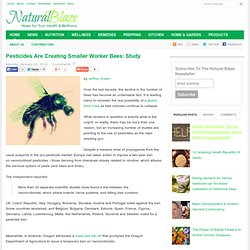
It is leading many to consider the real possibility of a global food crisis as bee colonies continue to collapse. What remains in question is exactly what is the culprit. In reality, there may be more than one reason, but an increasing number of studies are pointing to the use of pesticides as the main smoking gun. Colony Collapse Disorder Is a Fraud: Pesticides Cause Bee Die-Offs. Heidi Stevenson, Green Med InfoWaking Times Years ago, Gaia Health informed that bee dieoffs are a direct result of pesticide nerve agents called neonicotinoids.

The term, Colony Collapse Disorder, is fraudulent, designed to direct attention from the known cause. Agribusiness, the poison manufacturers making death-producing pesticides, is the other face of Big Pharma. The massive bee die-off is not a great mystery. This New Finding Explains Why Bees Are Disappearing. Amanda Froe lich, GuestWaking Times The secret is out – bees have been disappearing for almost a decade now, and scientists are scrambling to understand why. Some sources relay that the colonies all across the world are vanishing due to pesticides, electromagnetic frequencies, mites, and even GMO crops, but what researches have recently found to be the cause of the bee catastrophe will shock you. Diesel Fumes Could be to Cause for Global Food Crisis. By: Amanda Froelich, True Activist. Every choice has a consequence, an admonishment which is finally starting to be understood in our world of technological advances and consumer driven society.
Especially pertaining to the usage of petroleum-based fuel sources, of rising concern is the environmental impact man’s unsustainable lifestyle has had and is having on wildlife, notably the bee. Responsible for more than just creating honey, the extent of a bee’s impact on the worldwide chain has yet to be fully understood. The diligent and hard working bee is an integral player in cross pollination. Scientists discover what’s killing the bees and it’s worse than you thought. By Todd Woody As we’ve written before, the mysterious mass die-off of honey bees that pollinate $30 billion worth of crops in the US has so decimated America’s apis mellifera population that one bad winter could leave fields fallow.
Now, a new study has pinpointed some of the probable causes of bee deaths and the rather scary results show that averting beemageddon will be much more difficult than previously thought. Scientists had struggled to find the trigger for so-called Colony Collapse Disorder (CCD) that has wiped out an estimated 10 million beehives, worth $2 billion, over the past six years. Suspects have included pesticides, disease-bearing parasites and poor nutrition. Colony Collapse Disorder Is a Fraud: Pesticides Cause Bee Die-Offs. Researchers find high-fructose corn syrup may be tied to worldwide collapse of bee colonies. (Phys.org) —A team of entomologists from the University of Illinois has found a possible link between the practice of feeding commercial honeybees high-fructose corn syrup and the collapse of honeybee colonies around the world.
The team outlines their research and findings in a paper they've had published in the Proceedings of the National Academy of Sciences. Since approximately 2006, groups that manage commercial honeybee colonies have been reporting what has become known as colony collapse disorder—whole colonies of bees simply died, of no apparent cause. As time has passed, the disorder has been reported at sites all across the world, even as scientists have been racing to find the cause, and a possible cure.
To date, most evidence has implicated pesticides used to kill other insects such as mites. Commercial honeybee enterprises began feeding bees high-fructose corn syrup back in the 70's after research was conducted that indicated that doing so was safe. Press release.